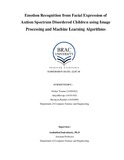| dc.contributor.advisor | Chakrabarty, Amitabha | |
| dc.contributor.author | Tasnim, Nishat | |
| dc.contributor.author | Khwaja, Atiya | |
| dc.contributor.author | Rashid, Humayra | |
| dc.date.accessioned | 2019-02-26T06:47:54Z | |
| dc.date.available | 2019-02-26T06:47:54Z | |
| dc.date.copyright | 2018 | |
| dc.date.issued | 2018-12 | |
| dc.identifier.other | ID 14301022 | |
| dc.identifier.other | ID 14101103 | |
| dc.identifier.other | ID 14101099 | |
| dc.identifier.uri | http://hdl.handle.net/10361/11469 | |
| dc.description | This thesis is submitted in partial fulfilment of the requirements for the degree of Bachelor of Science in Computer Science and Engineering, 2018. | en_US |
| dc.description | Cataloged from PDF version of thesis. | |
| dc.description | Includes bibliographical references (page 37-39). | |
| dc.description.abstract | Emotion recognition from facial expression is one of the most popular research sectors in Computer Science for last several years. As face recognition of different people is already established and become very common in almost everywhere, emotion recognition from these faces can be a new feature in the existing processes. On the other hand, image processing is the new emerging field in Computer Science. There are already several well renowned researches on facial expression recognition using image processing. In our research, we have recognized the emotions of children who have Autism Spectrum Disorder (ASD).Most autistic children show symptoms of withdrawal from social interactions and a lack of emotional empathy towards others. Individuals with autism exhibit difficulties in various aspects of facial perception, such as facial identity recognition or recognition of facial expressions. Our goal is to find a way that can understand their emotions accurately so that further improvement based on our research in this field can find a pattern of their expressions for different emotions and can make it easy for them as well as for the people surrounded by them to interact with each other. For our research, we have used seven Machine Learning algorithms along with Convolutional Neural Networks (CNN) through the datasets of different expression of ASD children and compared the accuracy to find out the algorithm/s that identifies their expression most perfectly. We also demonstrated two feature extraction techniques that are PCA and LBP to improve the accuracy of the algorithms. Our approach shows some mentionable output. The best result we get is after using SVM with PCA feature extraction that gives almost 68.2% of accuracy. | en_US |
| dc.description.statementofresponsibility | Nishat Tasnim | |
| dc.description.statementofresponsibility | Atiya Khwaja | |
| dc.description.statementofresponsibility | Humayra Rashid | |
| dc.format.extent | 39 pages | |
| dc.language.iso | en | en_US |
| dc.publisher | BRAC University | en_US |
| dc.rights | BRAC University theses are protected by copyright. They may be viewed from this source for any purpose, but reproduction or distribution in any format is prohibited without written permission. | |
| dc.subject | Facial Expression Recognition | en_US |
| dc.subject | Image processing | en_US |
| dc.subject | Autism Spectrum Disorder | en_US |
| dc.subject | Machine learning algorithms | en_US |
| dc.subject | Convolutional Neural Network | en_US |
| dc.subject | Feature extraction techniques | en_US |
| dc.subject.lcsh | Data mining | |
| dc.subject.lcsh | Machine learning | |
| dc.subject.lcsh | Neural networks -- Programming. | |
| dc.title | Emotion recognition from facial expression of autism spectrum disordered children using image processing and machine learning algorithms | en_US |
| dc.type | Thesis | en_US |
| dc.contributor.department | Department of Computer Science and Engineering, BRAC University | |
| dc.description.degree | B. Computer Science and Engineering | |

